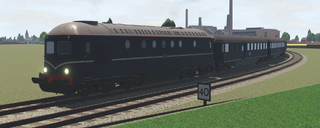| NS 2600 | |
|---|---|
| by Supersnel11 | |
| Price | ƒ110.000 |
| Level | 28 |
| Statistics | |
| Type | Mixed |
| Top Speed | 100 km/h |
| Weight | 108 tons |
| Capacity | 440 tons |
| Passenger Capacity | 1 first class 2 second class |
| Length | 19,9 meters |
The NS 2600 was a class of six Dutch (A1A)’(A1A)’ (two six-wheeled bogies of which the outer four wheels are powered) diesel locomotives. They were some of the least succesful diesels of the Nederlandsche Spoorwegen.
Variants
The NS 2600 is available in Nederlandsche Spoorwegen blue and brown.
Historical details
The design
The electrification of the Dutch railway network progressed more slowly than desired after the Second World War. The Nederlandse Spoorwegen (NS) sought a diesel locomotive to transport passengers on lines that had not yet been fitted with overhead wires, which included most of the southern Netherlands.
Werkspoor, a Dutch locomotive manufacturer, designed a four-axle diesel locomotive powered by a ship's engine. In early May 1949, NS ordered 27 of these locomotives. However, the engine was too heavy, necessitating modifications to lighten the axle load. Soon after, it became evident that the selected engine was unsuitable for handling varying loads. Despite Werkspoor's various attempts to resolve this issue, none were successful, leading NS to cancel their order.
Service years
By the time the order was cancelled, six locomotives and the engine of a seventh were already built, which NS did get. The first would be trialed on 7 January 1953 as NS 801. 801 would be renumbered in the following month due to an NS policy to give non-shunters numbers above 2000. NS 2602-2606 would be delivered with those numbers. Because the class was the strongest NS had at the time, they got the highest numbers.

They were stationed at Eindhoven depot, from where they pulled international passenger trains that headed through Venlo, international trains to the Belgium Harmont, and regular passenger trains to Geldermalsen and Roermond. They would pull standard passenger trains on the section from Eindhoven to Venlo to replace the DE-3s and DE-5s from 1955 to 1957, after which they were exclusively put on goods trains.
In their years of service, the general public would nickname the class "Beelen" or singular engines a "Beel", because their windows made them resemble Louis Beel, a Dutch politician and Prime-Minister between 1946-1949 and 1958-1959.
Because NS wanted to paint all their diesel-electric locomotives brown, NS 2601, 2602 and 2606 were repainted in 1954. The other three remained blue.

The entire class was withdrawn in 1958 and scrapped in 1960.
Technical details
Standard details
The NS 2600s were 20 metres long, 4,56 metres tall and weighed 108 tonnes. They could hold 2.900 litres of fuel.
They had a slow-speed, two-stroke ten-cylinder diesel engine of the Stork-Thomassen type STT 10 x 24/36 that could produce 1350 horsepower. The generator was a Smit type G 110/39, which fed four traction engines produced by HEEMAF.
The engine was cooled by two purge air fans on the roof, powered with the engine's crankshaft.
To start the engine, the reversing wheel had to be in the neutral position. Additionally, if the engine was cold it would have to be heated with the cooling liquid. This was achieved with a kerosene builder built into the circuit. Once the engine was turned on and a direction was selected, the control drum would be turned into provide traction.
Engine troubles
The engines were originally developed for ships, though a locomotive version was made because of similar engines used in locomotives in the United States and a bias NS had developed against faster engines due to troubles with the DE-3 trainsets. The people who accepted the design failed to take into account that locomotives in the US tend to travel longer distances at lower speeds and are switched off less often, maintaining a mostly constant load. Comparatively, the loads on engines used for Dutch train services varied much more, yet it was unknown how this would affect the engines. Additionally, the engines would operate at a lower RPM, so the generators were bigger than those of the US to compensate.
One of the first problems to be noted was that the cylinder lining would tear as it wouldn't expand fast enough under the varying loads and would deform. When the engines cooled down, the process would be reversed which would fatigue the metal and lead to tears.
The high weight of the engine, traction engines and generator forced Werkspoor to lighten the mechanical part of the locomotive in order to remain within the 108 ton limit. This was partially achieved by using aluminium, which had the downside of being expensive and vulnerable to damage.
Werkspoor did offer to replace the Stork-Thomassen engine with one of their own, though NS found it easier to withdraw and scrap the series.
Trivia
- NS 2601 had a brown livery with the stripe painted a bit higher, but this isn't reflected in-game.
- The NS 2600 is the only mainline diesel that has spoked wheels.
- Prior to version 0.8.6, the wheels were unanimated disk wheels, like all other mainline diesels.
- On accident, the Festive NS 2600 was released without spoked wheels in version 0.8.6.
- Prior to version 0.8.6, the wheels were unanimated disk wheels, like all other mainline diesels.
- The middle axle of each bogie has slightly smaller wheels compared to those of the outer two axles.
- The NS 2600 is the longest diesel locomotive at 19,9 meters.
- The NS 2600 has been available since the game's launch, version 0.1, in both liveries.
Gallery
-
A set of doubleheading NS 2600s with a goods train heading towards Kesteren.
-
NS 2602 leaves Helmelo with a passenger train.




